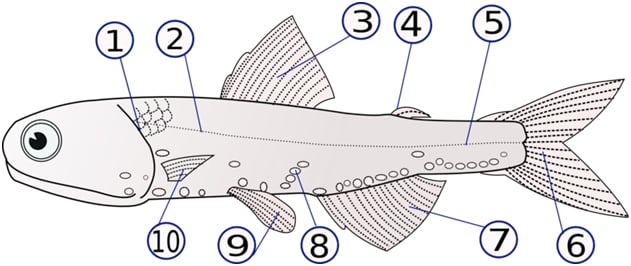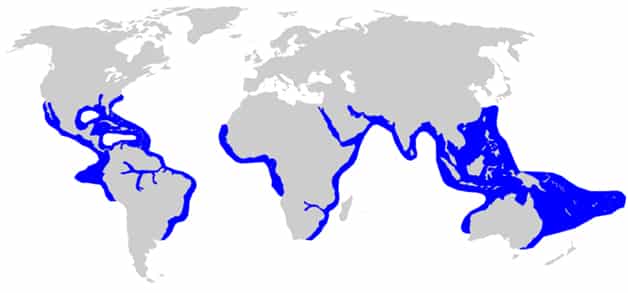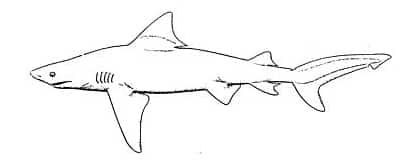Fish:
- Aquatic vertebrate animals
- Typically cold-blooded
- Covered with scales
- Equipped with two sets of paired fins and several unpaired fins
Kingdom: Animalia
Phylum: Chordata
The anatomy of Lampanyctodes hectoris
(1) – operculum (gill cover), (2) – lateral line, (3) – dorsal fin, (4) – fat fin, (5) – caudal peduncle, (6) – caudal fin, (7) – anal fin, (8) – photophores, (9) – pelvic fins (paired), (10) – pectoral fins (paired)
- Most fish exchange gases by using gills that are located on either side of the pharynx.
- Gills are made up of threadlike structures called filaments.
- Each filament contains a network of capillaries that allow a large surface area for the exchange of oxygen and carbon dioxide.
- Fish exchange gases by pulling oxygen-rich water through their mouths and pumping it over their gill filaments.
- The blood in the capillaries flows in the opposite direction to the water, causing counter current exchange.
- Push the oxygen-poor water out through openings in the sides of the pharynx.
- Some fishes, like sharks and lampreys, possess multiple gill openings.
- Fish have a closed circulatory system with a heart that pumps the blood in a single loop throughout the body.
- As with many aquatic animals, most fish release their nitrogenous wastes as ammonia.
- Some of the wastes diffuse through the gills into the surrounding water.
- Others are removed by the kidneys, excretory organs that filter wastes from the blood.
- Over 97% of all known fishes are oviparous, that is, the eggs develop outside the mother’s body.
- In the majority of these species, fertilisation takes place outside the mother’s body
- The male and female fish shed their gametes into the surrounding water.
BullShark
Kingdom: Animalia
Phylum: Chordate
Class: Chondrichthyes
Subclass: Elasmobranchii
Order: Carcharhiniformes
Family: Carcharhinidae
Genus: Carcharhinus
Species: C. leucas
- The bull shark, whaler shark, Zambezi shark, Zambi, Nicaragua
- A shark common worldwide in warm, shallow waters along coasts and in rivers.
- The bull shark is well known for its unpredictable, often aggressive behaviour.
- Unlike most other marine sharks, bull sharks tolerate fresh water.
- They can travel far up rivers.
- Probably responsible for the majority of shark attacks on humans that take place near the shore
Distribution of Bullsharks
Found:
- India
- Australia
- Africa
- In the Atlantic it is found from Massachusetts to southern Brazil and from Morocco to Angola.
- Vietnam
- In the Pacific Ocean, it can be found from Baja California to Ecuador.
Anatomy and appearance
- Bull sharks are large and stout.
- Males can reach 2.1 m (6 ft 11 in) and weigh 91 kg (200 lb).
- Females can be much larger; up to 4 m (13 ft 1 in) and 318 kg (700 lb).
- Bull sharks are wider than other requiem sharks of comparable length
- Grey on top and white below. The second dorsal fin is smaller than the first.
- Made of cartilage, multiple gills.
Bull sharks= carnivores
Diet:
- Fish
- Other sharks
- Rays
- Dolphins
- Turtles
- Birds
- Molluscs
- Echinoderms
- Crustaceans
Reproduction
- Bull sharks breed in the summer, often in the brackish water of river mouths
- After gestating for about a year, a bull shark may give birth to as many as 13 live young
- They are viviparous=Embryo develops inside the body of the mother, as opposed to outside in an egg; mother then gives live birth.
- The young are about 70 cm (28 in) at birth and take 10 years to reach maturity
Importance of Fish in Ecosystem
Both schooling and solitary fishes are essential residents of the reef ecosystem. Fishes play a vital role in the reef’s food web, acting as both predators and prey. Their leftover food scraps and wastes provide food or nutrients for other reef inhabitants.
| • | Some species of sharks, skates, and rays live on or near the reef. Others swim in to eat. Shark species include lemon, nurse, Pacific blacktip, white-tipped reef, and zebra sharks. These sharks as well as rays generally eat crabs, shrimps, squids, clams, and small fishes. |
| • | Parrotfish use chisel-like teeth to nibble on hard corals. These fish are herbivores and eat the algae within the coral. They grind the coral’s exoskeleton to get the algae, and defecate sand. A single parrotfish can produce about five tons of sand per year. |
| • | Wrasses comprise a large group of colorful cigar-shaped fishes. Some species are known as cleaners, and set up cleaning stations along the reef. When a larger fish aligns itself at one of these cleaning stations, a cleaner wrasse removes parasites from the fish. |
| • | Eels are one of the reef’s top predators. These fishes live in crevices in the reef and venture out at night to hunt and feed. They have sharp teeth set in a powerful jaw. Eels eat small fishes, octopuses, shrimps, and crabs. |
| • | Other fishes found on the reefs include angelfishes, butterflyfishes, damselfishes, triggerfishes, seahorses, snappers, squirrelfishes, grunts, pufferfishes, groupers, barracudas, and scorpionfishes. |
* Fishes are also potentially linked to buffering climate change.



